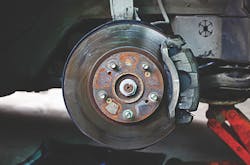For years many drivers have “listened” to their automobile’s brakes to determine when it was time for a replacement. The Ford Motor Co. is developing a new system that will not only alert drivers when their brakes might need replacing, but it will also send the information to a mobile device.
Ford has become the first auto manufacturer to conduct experiments — dubbed the Condition Based Maintenance Project — with new connected vehicle technology, and this can be used to predict when a vehicle’s brakes will need servicing. The technology monitors 25 different signals and includes onboard vehicle sensors as well as cloud-based duty cycles prognostics. From this, a text message can be sent to the driver that it is time to service the vehicle.
Since December of this year, the Dearborn, Michigan-based automaker has been testing this service in several Ford-owned fleets, but will expand it to other fleets and eventually retail customers. Throughout the tests, Ford has tested this technology in a number of select Ford management-lease vehicles, where each was driven by different people with varying commuting routes; as well as usage and braking habits.
The system constantly analyzes all incoming data, including when the brakes are pressed, the velocity of the vehicle when brakes are applied and even the amount of pressure that is applied by the driver.
Telematics Study
The Condition Based Maintenance Project is just the latest way OEMs are now communicating with the vehicles through a system called telematics. This allows dealers to reach out to a consumer, but it also enables the consumer to have a better understanding of when a repair may be necessary.
“One part of this is certainly a business development effort to get the owner of the vehicle back to the dealer for parts and services,” said Stephen Spivey, automotive and transport program manager at the Frost & Sullivan research firm. “This is all built around connected vehicle technology that collects and sends out data. In today’s connected vehicles the data never stops coming.”
In the tech world this constant flow of information even has a name: “Big Data.” For drivers it can make a big difference between thinking the brakes need replacing to knowing that they do.
“This technology can help drivers know before they head to the garage that they may need something or not,” said Oleg Kusikhin, technical leader with Ford Motor Company. “Drivers will get a warning that they may need to change brakes or how long they may have until such a repair is necessary.”
Kusikhin compared the technology to oil change indicators, which have advanced in modern automobiles from a mere “oil light” to an indicator that tells the drivers the number of miles they can go until the next change is due.
“This is one of the most important advances we’re looking into,” added Jovan Zagajac, connected vehicle technology manager at the Ford Motor Company. “We’re really trying to put the consumer at the center of this connected universe to make sure that they are kept up-to-date and informed about the health of the vehicle.”
For many drivers a warning indicator is enough to get them to the shop, but the problem is this isn’t always convenient. Ford’s new technology isn’t just about warning the customer, it is about predicting and giving some notice so the customer can make an informed decision and schedule the maintenance when it is convenient.
“This can be very useful for fleet planning as schedules can be addressed accordingly,” Kusikhin said. “We can help people plan ahead for when a vehicle will be taken out of service.”
The messages sent to a user’s device can also be integrated with scheduling software.
“A warning light can’t put a notice on your calendar, but this could be used to do so,” Zagajac noted.
To the Dealer and Beyond
This technology is certainly there to get customers back to the dealer, but it could also get drivers to the local garage or shop just as easily.
“This technology may be directly designed to benefit the independent shop, but it is good for service for the industry as a whole, as there is the likelihood for repairs across the entire business channel,” Spivey said.
Oil and lube shops that already have experience with telematics have told National Oil & Lube News this technology is a win for the industry.
“This is certainly an interesting use for telematics,” said Scott Morrison of National Autotech Inc., City Garage in Duncanville, Texas. “This is the first time we’re seeing it with brake diagnostics, but we’ve seen it with batteries and other alerts.”
Where it truly serves to help the shops is that customers have the data directly from their vehicle, and thus may not feel they’re being upsold when a technician says brake work might be necessary.
“Customers will believe a computer before they believe a technician,” added Morrison, who has 14 stores in the Dallas/Fort Worth area. “Any way the customer is educated or forewarned, it does everyone in the aftermarket a lot of good. This improves customer expectations and helps them understand that they may need a brake replacement.”
Because the data comes from the vehicle and it alerts that a brake repair could be coming, it gives the customer some notice.
“Customers are more sophisticated today, and the telematics are a great way of letting them — the drivers — know the car needs service,” Morrison said. “And they want it. The driver today doesn’t want to depend on hearing or smelling, and most drivers of new cars believe the car is actually smart enough to provide this information.”
Long-term, it could provide an opportunity for shops that seek to do more brake jobs or get involved in this business. However, it could still be a while before this technology is widely adopted by all automakers, but it is certainly coming, and those shops that are early adopters could be well-positioned as the industry moves toward greater use of telematics for brakes, oil and more.
If there is a downside, it is that perhaps a little information can be dangerous. In some cases the car’s computer may predict when brakes need to be changed based on driving habits. But is it taking into account other aspects such as environment or climate?
Morrison noted many of his customers used to come in at 3,000 or 5,000 miles for regular oil changes, but now wait for the car’s indicators to come on.
“In our part of Texas we deal with stop-and-go driving, intense heat as well as cold weather in the winter, and we like to see drivers come in at 5,000 miles for an oil change,” he said. “A lot of people now wait for the oil light. So we have to educate them that this is planned obsolescence from the manufacturer.”
About the Author

Peter Suciu
Peter Suciu is Michigan-based writer and NOLN freelance contributor who has contributed to more than four dozen magazines, newspapers and websites. He lives in the land of cars not far from one of Henry Ford's estates.
